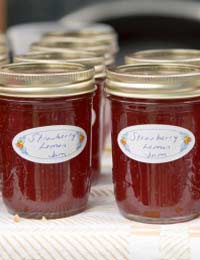How to Make Jam

Making a good jam is easy if you know the fundamentals. Learning the various processes can allow you to discover many new ways to use up fruit in tasty and long-lasting recipes that can be given as gifts as well as enlivening your family’s breakfast table.
Jam Facts
There are three things that need to happen for a jam to form, pectin (which is a naturally occurring substance in most fruits) has to react with sugar and fruit acids to thicken and form a gel that preserves the fruit.Because fruits can interact with sugars to create surfaces on which bacteria can multiply rapidly, it’s vital to clean and sterilise equipment and jars to minimise any risk to health.
The Many Varieties Of Jam
A classic fruit jam is made from fruit cooked to a pulp which is then heated to a high temperature with sugar until it sets. This is called a jelly when the fruit has been cooked to a pulp but is strained through a cloth to remove any pieces before heating with sugar. Some jellies are less sweet than jams and served with meats rather than as a dessert. A conserve is similar to a jam but because the whole fruit is used and ‘conserved’ as closely to its original shape as possible, and because there is often the addition of some alcohol, the resulting sweet fruit mixture is not encourage to set as thoroughly and instead the fruits are preserved in a sugar-heavy syrup. A marmalade is a high-citrus jam that relies on the bittersweet qualities of citrus fruit to make a highly distinctive form of preserve usually served with breakfast breads.Top Tips For Good Jam Making
- Because pectin is highest in slightly under-ripe fruit, try to choose fruits that are in good condition and not over-ripe. Pectin becomes pectose in over-ripe fruit and this causes two problems: the jam will not set as well and it may also deteriorate quickly.
- Ensure your jars are super-clean. Wash the jars thoroughly, using some sterilising fluid of the kind used for babies’ bottles if you want to be ultra-certain about cleanliness. To be sure that they remain sterile put the clean jars in a cool oven (around 130C or gas .5) for fifteen minutes.
- Make sure you use the right amount of sugar. The classic proportion is 50:50 for a jam, which means 450 grams sugar to 450 grams fruit, but in very high pectin fruits you may want to add a little more sugar to keep it sweet and in low pectin, high sugar fruits such as strawberries, you can drop a little sugar to stop the jam being cloying.
- There are specialist jam sugars that give a clear, tasty, well-setting jam, you can use fine sugars but they are more difficult to dissolve which can destroy some of the flavour of the jam and give a cloudy effect.
Pectin Contents Of Common Fruits
High-pectin fruits: black, red and white currants, cooking apples (especially if the skin is included in the recipe) damsons, quinces, gooseberries.Low-pectin fruits: strawberries, raspberries, blackberries, cherries, pears, rhubarb.
Related Articles in the 'Stocks & Sauces' Category...
- How to Make Chutney
- Types, Methods and Consistencies of Sauces
- Useful Sauce Tips and Serving Suggestions
- Easy Steps to Egg-Based Sauces.
- Roux-Based Sauces: What, How and When
- How to Make a Simple Tomato-Based Sauce.
- Vegetable Stock: Tips On How to Make and Use
- Game Stock: How to Make and When to Use
- Fish Stock: The Basics
- What is Brown Stock and How is it Made?


Re: Types of Pastry
I have never seen samosas made with filo. While the dough is thin it is very different from filo. I have made both and the process is very different.
Re: How to Make Perfect Short Crust Pastry
Would you please provide the links for: 1. Apple tart or galette crust 2. Apple pie crust 3. Can an enriched…
Re: Types of Pastry
Have you a recipe for hard pastry used for encasing joints of meat and poultry before baking in an oven at low temperature? I think it is called…
Re: Making Fruit Pies and Crumbles
i make crumble with corn corn flakes i make them into crumbs and the whole thing taste nice
Re: Types of Pastry
yes i like it crusty but also a bit moist. i think it adds the fun if it's smooth and moist. i don't really like it if it is flaky. it also needs a…
Re: Types of Pastry
what is the difference between flaky pastry and rough puff pastry
Re: Types of Pastry
Pastry is kinda complicated but at some point it's under stood thanos for the information that helps us learn
Re: Types of Pastry
My dad left to the shop to get some pastry five years ago, has anyone seen him??
Re: Types of Pastry
MY NAN has some nice pastry if someone wants some
Re: How to Make Chutney
I allowed my chutney to go cold before I put it in jars....will it compromise the taste or how long it will last?